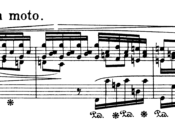Analysis
Contents
First Movement (Allegro Moderato)
Form: Sonata Form. A Major.
EXPOSITION (Bars 1-47):
Themes introduced in tonic and dominant keys.
FIRST SUBJECT:
Bars 1-20: First subject theme – an eight-bar melody, ending with a perfect cadence in A major. The melody features dotted rhythms, and there is an almost-continuous quaver (eighth note) accompaniment. There is a brief move to B minor in Bars 5-6.
Bars 9-12 are a variant of the theme in F sharp minor (relative minor) with the bass imitating the treble in Bars 9-10.
In Bars 13-20 the opening theme returns in A major, with small variations.
Bar 20: Transition. Very brief! The triplets introduce the new accompaniment rhythm, and the D sharp at the end of the bar eases the piece into E major (dominant).
SECOND SUBJECT:
Bars 21-41: Second Subject theme – an eight-bar melody, ending with a perfect cadence in E major. After a four-bar interlude, the melody is presented in the bass (Bars 34-37) in E minor then F minor, before the key of E major returns.
CLOSING SUBJECT:
Bars 42-47: Closing theme. In E major, with some chromaticism, frequently with a tonic pedal in the bass. The rhythms used are taken from the second subject.
DEVELOPMENT (Bars 47-79):
Themes reworked in various keys.
Bars 48-56: First subject theme, in F sharp minor, then E major (Bars 50-51), and C sharp minor.
Bars 57-64: Triplets, reminiscent of the transition, in C sharp minor, then D major (from Bar 59), preparing for the return of the tonic key with a German augmented sixth chord in Bar 64.
Bars 65-79: Mostly in A major. The closing theme is heard in imitation between the hands, alternating with snatches of the first subject.
RECAPITULATION (Bars 80-126):
Themes restated, now mostly in the tonic key.
Bars 80-99: First subject. As before, with small changes in voicing and register, A major.
Bar 99: Transition. As before.
Bars 100-120: Second subject. Begins as before, but soon (i.e. Bar 102) returns to A major, where it remains except for brief moments in A minor (Bars 113-114) and F major (Bars 115-116).
Bars 121-126: Closing theme, A major, with some chromaticism, and frequently with a tonic pedal in the bass.
CODA (Bars 127-133):
Bars 127-133: Coda. Based on the first three bars of the first subject theme, all in A major (with diminished seventh chords in Bars 128 and 131).
Second Movement (Andante)
Form: Sonata Form. D Major.
EXPOSITION (Bars 1-32):
Themes introduced in tonic and mediant keys.
FIRST THEME:
Bars 1-15: First subject theme – all in D major, featuring a recurring rhythmic pattern, ending with a perfect cadence in Bars 14-15. The accented chords contain appoggiaturas (non-harmonic or dissonant notes) in the top voice for added expressiveness.
SECOND THEME:
Bars 16-26: Second subject theme. Begins with a similar rhythm to the first subject theme, above a semiquaver (sixteenth note) accompaniment, in F sharp minor, ending with an interrupted cadence in Bars 25-26.
DEVELOPMENT(Bars 33-49):
Themes reworked in various keys.
Bars 33-49: A rhythmic transformation of the first subject theme, over a triplet accompaniment, in G major (subdominant). Returns to D major in Bar 42, with an Italian augmented sixth chord in Bars 43 and 45, and a dominant pedal in Bars 46-49.
RECAPITULATION (Bars 50-75):
Themes restated, now tin the tonic major or minor keys.
FIRST THEME:
Bars 50-59: First subject theme returns in D major, with some imitation in the bass. The tonality shifts to D minor (tonic minor) in Bars 58-59.
SECOND THEME:
Bars 60-69: Second subject theme, in D major then D minor (from Bar 67), ending with a perfect cadence in Bars 69-70.
CODA:
Bars 70-75: Closing theme, D major, with a tonic pedal in the bass.
Third Movement (Allegro)
Form: Sonata Form. A Major.
EXPOSITION (Bars 1-84):
Themes introduced in tonic and dominant keys.
FIRST SUBJECT:
Bars 1-19: First subject theme, A major, with tonic pedal for the first ten bars – soft and lyrical.
TRANSITION:
Bars 19-34: Transition. Suddenly loud, with sforzandi. There are suggestions of F sharp mionr in Bars 21-22 and 28-29, and a modulation to E major (dominant) in Bar 33.
SECOND SUBJECT:
Bars 35-84: Second subject theme. Mostly E major. The melody features dotted notes and mordents, and is shared by the right hand (mostly soft) and the left (mostly loud). There are brief suggestions of C sharp minor (indicated by B sharp), and F sharp minor (with E sharp). The closing subject begins from Bar 61 to Bar 84.
DEVELOPMENT (Bars 84-121):
Themes reworked in various keys.
Bars 85-91: First subject theme, in F sharp minor (relative minor), above a dominant pedal at first.
Bars 92-121: Based mostly on the first seven notes of the first subject. Moves from F sharp minor to A major (Bar 94), C sharp minor (Bar 97), B minor (Bar 102), and, after a sequential passage, returns to A major in Bar 114.
RECAPITULATION (Bars 121-205):
Exposition transposed up a forth, so as to end in the tonic key.
Bars 121-140: First subject theme returns in the subdominant key (D major).
Bars 140-155: Transition. A fourth higher than in the Exposition.
Bars 156-205: Second subject. A fourth higher than in the Exposition, so that it is now in A major.
CODA (Bars 205-216):
Bars 205-216: Coda. A final statement of the first subject, in A major, above a tonic pedal.









